Victor E. Smith's Blog, page 6
February 11, 2013
Paranormal Series #1: Is Paranormal the new Normal?

Stunning View of the city and distant Rincons from Tucson Mountain Park 2/9/13
As a writer who works in the paranormal novel genre and a reader who indulges in paranormal non-fiction as well, I thought to put together a series, threaded through my blog among other subjects as the “spirit” moves me, on paranormal phenomena. Perhaps to justify the time splurged on material that many consider wishful thinking at best and diabolic at worst. More likely, I’m looking to start some thoughtful cyber-conversation among people, especially other writers, on an evolutionary premise that is headed in the right direction but requires a lot more discussion, experimentation, and improvement to be considered a practical reality. That theory in a sound bite: today’s paranormal will be tomorrow’s normal.
The long dictionary definition of paranormal is “pertaining to the claimed occurrence of an event or perception without scientific explanation, as psychokinesis, extrasensory perception, or other purportedly supernatural phenomena.” The shorter one is “beyond normal explanation.” Since it contains the word normal, with the prefix para (meaning either beyond, above, below or in some relationship with), the very word assumes two distinguishable groups of objects or experiences: normal and paranormal.
But we know what a slippery critter normal can be. Like junk and treasure, one person’s normal is another person’s nuts—The Gods Must be Crazy kind of nuts. Put time and science into the mix, and the Fun House becomes berserk. What if someone from a mere 150 years ago were zapped into the present? Could he be blamed for calling jets UFOs, or claiming TV shows or movies are supernatural visions, or saying he was channeling other dimensions through voices issuing from a phone? He might try to destroy computers as instruments of the devil (even when there is no problem with Windows). There are hundreds of instances where science or closer observation has normalized the paranormal.
And according to cutting edge scientists and futurists, we ain’t seen nuttin’ yet. Ervin Lazlo, philosopher and Nobel Peace Prize nominee writes: “The ability of altered states to convey veridical [genuine] information about the world was known to traditional peoples who prized and cultivated them for the powers they confer. But modern people think of altered states as pathological—a sign of disease, of dementia, or of being high on drugs… Natural healers, leading-edge psychiatrists, and consciousness researchers have a different view of such states. The psychiatrist John Nelson, for example, considers altered states basic to the human psyche, with one end of the spectrum shading into madness and the other reaching the loftiest realms of creativity, insight and genius.” (Science and the Akashic Field, p. 99)
It can be said that no class of humans has been persecuted for so long and as violently as the occultist (occult means, by the way, “beyond the range of ordinary knowledge or understanding”; another word for paranormal). Natural healers were labeled witches and burned at stake. Prognosticators who proved too accurate had their books burned, if not their bodies. Wizards, like the Druids, had to choose between conversion and exile. Even today, people who perform feats that defy accepted science are quickly labeled quacks. (Granted, there are some ducks out there who will sell you an expensive route to paranormal powers that turns out to be a expressway to nowhere!)
However, I am inviting all occultists to come out of the closet. (Wear an asbestos suit if you are still leery of lurking inquisitors.) Contribute your paranormal experience, theories, and objections to the conversation: Will today’s paranormal become tomorrow’s new normal?
NEXT TIME: PAST LIFE RECALL: REQUIRED FOR PSYCHOLOGICAL WHOLENESS?
********
 Click to subscribe to this site’s RSS Feed.
Click to subscribe to this site’s RSS Feed.Click this link to order a copy of The Anathemas, a Novel about Reincarnation and Restitution.
Copyright 2013 by Victor E. Smith. All rights reserved.
Share your thoughts on this post. Put in your comment in the space below. Thank you.
January 18, 2013
The Anathemas Q-and-A: Why a Novel rather than Non-fiction?

Obelisks in the remains of the Hippodrome, Istanbul
So here I was with a mystery that went back millennia and touched the lives and minds of half the world’s population. Why not just write the facts and let the reader come to his own conclusion? Why a novel?
Search the Internet and you will find thousands of items, from one extreme to the other, on reincarnation, Justinian, and the Council of Constantinople, but those gathered tracts and theories can leave one cold. By themselves, history can be stodgy and religion passé; but the inside-the-mind saga of people living multiple individual lifetimes, The Anathemas’ perspective, can electrify and revivify that vast region that lies behind barriers in ”normal” memory.
The Anathemas, as a novel, is fiction—a creation—not entirely dependent on the records of the past events depicted, even while it takes them into account. So, it is free to fill in where the record falls short, to adjust where the record seems in error, and to postulate the record’s impact—the advantage of hindsight—on later and present thinking and behavior. This, by the way, is also done in non-fiction, but the novel needs no footnotes to prove that what is being written is based on what someone else has already written.
Resorting to fiction, I’ll admit, can be a defensive device. Those with a vested interest in keeping reincarnation under wraps are still around. As Dan Brown learned with The Da Vinci Code, even the best-plotted fiction, coming too close to debunking enshrined myths, generates furious backlash.
Fiction as a present-time Event
The word, fiction, essentially means “something created.” It’s root fict- is only one letter off from fact. From the predominant mechanical viewpoint, we give more credence to theories made up from sense phenomena than to those conjured up from the thin air of imagination. We call the first science and the latter fantasy. And yet we flock to concerts, art museums, movies, and sporting events or park for hours in front of TVs, all more fantasy than science.
In his book, Beyond the Occult, Colin Wilson says: “Imagination is the power to anticipate reality by conjuring up mental connections.” The fiction writer conjures consciously, usually with the intent to anticipate, or foresee, a present or future reality.
The Anathemas is based on a piece of history that takes place in the 6th Century, a critical event that changed the course of western civilization up to the present. However, the restitution required of the Justinian character, the perpetrator of the untruth, is not in the 6th century, the time of the crime, nor in the 19th century with Richard Strawn, but in the present time, since the misinformation persists and will continue to do so until corrected. Examining a “given” idea, no matter how old, to establish its validity is a present time activity, for both writer and reader.
Erroneous history is a present problem. Our history—what has been recorded about our past—bounds our view of ourselves and our kind. It governs how we think in the present and thus plan, and so create, the future. The details, as they happened, might be lost, but the essentials cannot be.
As the Jesuit DuPont observes in novel: “But there’s good news. Perennial truth, which the words in any document can but poorly represent, remains perennially true. So, it remains there to be observed and verified by the present observer.” (P. 315)
********
 Click to subscribe to this site’s RSS Feed.
Click to subscribe to this site’s RSS Feed.Click this link to order a copy of The Anathemas, a Novel about Reincarnation and Restitution.
Copyright 2013 by Victor E. Smith. All rights reserved.
Share your thoughts on this post. Put in your comment in the space below. Thank you.
January 16, 2013
The Anathemas Q-and-A: Why not Reincarnation?
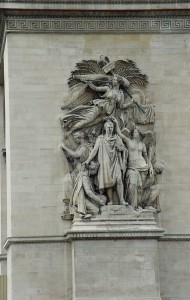
“History is written by the Winners.” Alex Haley. Sculpture, Arch of Triumph, Paris
It was in the quiet place that the most urgent questions came. Questions without answers that nagged until I held them up-close and personal. What if I did have previous lives? What might I have been or done? What difference would such knowledge make now? If I remembered, would I not be wiser for the previous experience? Would it explain some of those mysterious aspects of my personality that seem so random in the current context?
From “what if reincarnation?” personally, it was natural to go to “what if reincarnation?” for the human species.
After all, the eastern half of the world has held this belief for eons longer than the “one life, one death” concept has been around. Would it make any difference to a society if its people were aware, individually and collectively, of their personal predecessors and descendants? Who of us, when beyond prejudice and fear, is not curious, even eager, to know his own source and destination, and that of one’s immediate relations and the human race?
Who would not trade in the dismal declaration, Remember man that you are dust and unto dust you shall return! for a destiny more suited to man’s nobler aspirations? From “What if reincarnation?” it is a natural leap, at least theoretically, to “Why not reincarnation?”
History and tradition of little help
A venerable priest-friend, on hearing about The Anathemas, emailed me thus: “It just came to my mind that I forgot to tell you that, according to the teachings of the Catholic Church, there is no such thing as REINCARNATION.” For him, and millions across the ages, case closed. The Authority has spoken and so it is. Snarky to mention, but this same authority condemned Galileo as a heretic for observing and teaching that the earth rotated around the sun, not vice versa.
When healthy curiosity poses questions that contradict dogma, our creeds offer only further mysteries in explanation; and our sciences, excluding spirit, admit evidence only from the dust here before we came and left behind when life leaves the body, ignoring the role and effects of life itself.
Here our written history becomes a part of the problem. As Alex Haley, the author of Roots observed, “History is written by the winners.” And implied is that what is handed down is not always complete or even true. As a librarian warns the protagonist in The Anathemas: “History is no exact science. Historians, no matter how objective they try to be, are individuals with limited points of view. Even when they honestly tell what they see, they too often dishonestly claim that what they see is all there is to be seen.” (P.96)
********
 Click to subscribe to this site’s RSS Feed.
Click to subscribe to this site’s RSS Feed.Click this link to order a copy of The Anathemas, a Novel about Reincarnation and Restitution.
Copyright 2013 by Victor E. Smith. All rights reserved.
Share your thoughts on this post. Put in your comment in the space below. Thank you.
January 14, 2013
The Anathemas Q-and-A: Why a Novel about Reincarnation?

The author (2001) with the Delaware River near New Hope, Pennsylvania, behind. The fictional Foxtown in the novel is modeled after New Hope.
It was the late ‘60’s and the sacred icons we’d grown up with were tettering. My own young life too had taken a radical turn (pun intended) when I left a Catholic seminary in rural New Jersey for New York City at the height of the Hippie and anti-Vietnam-War movements. Eastern concepts, reincarnation among them, were patently groovy. Bridey Murphy had come and gone, and Audrey Rose was still below the horizon, but the idea that we might have lived before and would live once again was all the buzz among young adults.
I found the idea curious but irrelevant until I came across the story of Emperor Justinian and Empress Theodora. Given my theological background and classical bent, these characters provided a personal bridge from the more familiar ancient history to the choatic present.
A wannabe writer in my early 20’s, I never imagined that typing out a couple of one-page character sketches about this imperial pair would start a process, and not merely a writing project, that would span decades before completion. Their story was history and thus worthy of a self-defined scholar, but with a twist that defied the status quo enough to support my recently adopted unorthodoxy.
I didn’t know what of this reincarnation thing was true or false or what Justinian and Theodora actually had to do with it, but I was fascinated and sensed a story.
Hooked by my own story
In the introduction to The Dancing Wu Li Masters, Gary Zukav notes: “I realized that the book I was writing was more intelligent than I was. It was also funnier than I was, and it had a grander comprehension than I did.”
I too quickly discovered that my story had a mind of its own, and it made demands on the character and ability of its author. I had to be qualified to do the work. I wasn’t at first, so my life unfolded to make me so—a fascinating process, but quite another story.
Before long, it wasn’t me writing the book but the book shaping me. And that, on several occasions, resulted in gaps of seemingly unproductive years where I had to endure adventures I would not have chosen on my own. But even these, I came to understand, were the story marching at its own pace.
For the writer there was the process of going within to find the story and match its step. What in The Anathemas the protagonist calls the “quiet place”:
The river bank was his magic vantage point where even life’s discordant notes would blend into the symphony. That constant, flowing river was his personal Holy of Holies, the quiet place, where chaos flew off with only the lightest touch of his will to have it do so. It had to be approached, he remembered, on tiptoes with bare feet. The snap of a twig, the flap of a bird’s wing, any alien thought snaring a bit of his attention, and the sacred place would dissolve into a scene quite ordinary. (The Anathemas, p. 64)
********
 Click to subscribe to this site’s RSS Feed.
Click to subscribe to this site’s RSS Feed.
Click this link to order a copy of The Anathemas, a Novel about Reincarnation and Restitution.
Copyright 2013 by Victor E. Smith. All rights reserved.
Share your thoughts on this post. Put in your comment in the space below. Thank you.
January 11, 2013
The Anathemas Q-and-A: What’s the Story in the Novel?
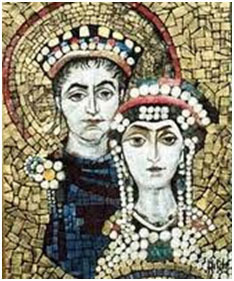
The Emperor Justinian and Empress Theodora. Sixth century mosaic
In 1879, Richard Strawn, a Civil War medic disowned by his fellow Quakers, has to come to terms with his daughter Jennifer’s conviction that she was once a fabulous queen and he a king, or concur with his wife, Lucinda, that the girl is hopelessly insane.
Burying his head by day in work and at night at the pubs, he delays the decision, betting that time will either cure Jennifer’s fantasies or soften Lucinda’s intransigence. Then, just when a truce appears to be holding between mother and daughter, nightmarish events erupt. A fire destroys the Philadelphia business Richard manages, and he is accused of arson. He escapes town, drunk and despondent, only to be pursued by a dream in which he is indeed a king, but a cowardly one about to capitulate to a revolting faction.
Lucinda takes advantage of his absence to have Jennifer committed to an asylum. With luck, which materializes as randomly as misfortune, Richard rescues the girl. While recovering, she too has the dream about the revolt, but she, the queen, boldly confronts the rebels and saves their realm. This baffling coincidence eventually leads them to the irresolute 6th-century Byzantine emperor, Justinian, and his profligate empress, Theodora. Compelled by inescapable fascination, father and daughter—sometimes in tandem, sometimes in opposition—set out to discover what binds them to this long-dead royal couple.
But Lucinda, like the black magician who successfully foiled the two in the earlier existence, is never far behind. She is determined to prove that history indeed repeats itself, and there is nothing they can do to stop it.
Meticulously researched in disciplines both outer (academic research, on-site observation)and inner, (meditation, daily journalling adding up to thousands of pages), The Anathemas is founded in history, notably Procopius’s Secret History and Gibbon’s Decline and Fall of the Roman Empire. But it is a story first and foremost—a mystery with generous dollops of grotesque Gothic and romantic “magical realism,” a dynamic roller coaster ride that hurls the reader through the action. One enthusiast said it was unlike any novel she’d ever read, a new genre of literature. Another declared it “life changing”.
********
 Click to subscribe to this site’s RSS Feed.
Click to subscribe to this site’s RSS Feed.Click this link to order a copy of The Anathemas, a Novel about Reincarnation and Restitution.
Copyright 2013 by Victor E. Smith. All rights reserved.
Share your thoughts on this post. Put in your comment in the space below. Thank you.
January 9, 2013
The Anathemas Q-and-A: What’s the History behind the Novel?
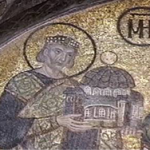
The Emperor Justinian depicted in a mosaic in the Cathedral of Hagia Sophia, Istanbul.
In 553 AD, Justinian I, the self-righteous ruler of the eastern half of the decaying Roman Empire, held Pope Vigilius prisoner until the church leader agreed to sign The Anathemas of the Council of Constantinople, previously convened by the emperor. Thus, with the stroke of the papal pen, anyone who believed in the ancient doctrine that souls existed before the present body’s birth or reincarnated after its death was excommunicated from the church, subject to persecution and eternally damned. This little-known power play between church and state served to prejudice the western world against the possibility of reincarnation right up to the present.
More than 25 years before, Justinian had married Theodora, a commoner and courtesan about 20 years his junior. When he became emperor in 527, he made Theodora empress and co-ruler. The marriage and elevation caused a scandal, but Theodora proved to be a potent leader in her own right as well as Justinian’s greatest supporter. She died in 548, perhaps of cancer, at a relatively young age, leaving the rudderless emperor to rule on his own for the remaining twenty years of his long life.
As if to assuage his grief, the emperor took to theology, usurping the rightful role of the clergy in deciding doctrine and proscribing heretics. Believers in reincarnation were just one group that felt his wrath.
Witnessing the triumphs and tragedies of the reign of Justinian and Theodora was the official court historian Procopius. While his public works are extravagant in their praise of his patrons, he also authored The Secret History, in which Justinian is cast as cruel and incompetent and Theodora, formerly a prostitute of insatiable lust, is shrewish, mean-spirited and manipulative as empress. It is to Procopius that we owe history’s ambivalent judgment of this imperial couple.
January 7, 2013
The Anathemas Q-and-A: Why the Odd Title?
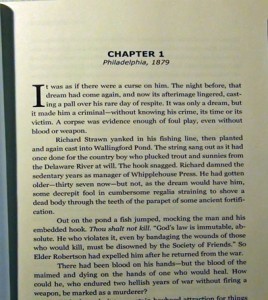
The Anathemas: Chapter 1
Given its name, it could be a novel about an eccentric family of exotic origin, but anathema is actually an ancient and provactive word used in English without translation.
Webster’s Dictionary cites it as derived from the Greek and meaning “a thing devoted to evil” although it previously signified “anything devoted” to a specific purpose. Immediately, we sense confusion here. The implication, however far-fetched, is that anyone or anything set apart in a special manner is somehow the servant of evil.
The Encyclopedia Britannica explores this turnabout in the word’s evolution. In the Old Testament, it explains, anathema designated a creature or object set apart for sacrificial offering. Its return to profane use was strictly banned, and such objects, destined for destruction, thus became effectively accursed as well as consecrated. Old Testament descriptions of religious wars call both the enemy and their besieged city anathema inasmuch as they were destined for destruction.
In New Testament usage a different meaning developed. St. Paul used the word anathema to signify a curse and the forced expulsion of one from the community of Christians. In AD 431 St. Cyril of Alexandria pronounced his 12 anathemas against the heretic Nestorius. In the 6th century anathema came to mean the severest form of excommunication that formally separated a heretic from the Christian church and condemned his doctrines.
Such reversals in the meanings of words are not unusual. Take the common word hot, which normally means something too warm to be bearable, but when the current generation says, “She’s hot,” hot means “extremely desirable.”
As the priest DuPont explains to the protagonist in the novel: “Beware of words, my friend. Over time, meanings change. In this case, the meaning reverses. Anathema, which now connotes the solemn condemnation of a person or thing as damned or cursed, originally meant an equally solemn dedication or setting aside of a person or thing as sacred, even divine.” (The Anathemas, p. 310)
The paradox inherent in the word anathema and the related practice of placing certain ideas out-of-bounds, a powerful form of mind-control, is at the heart of this novel. Thus, the title. Nor is it coincidence that the novels’s first line is: “It was as if there were a curse on him.”
Is it possible that centuries ago we were robbed, personally and collectively, of our true history, our immortal heritage, and then force-fed a myth about a rigid and unforgiving spiritual destiny that enslaved us to the robbers? Remember, man, that you are dust and unto dust you shall return!
January 4, 2013
The Anathemas Q-and-A: Introduction to Blog Series
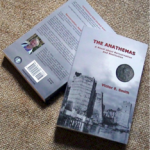 In the few years since the publication of my first novel, The Anathemas, A Novel about Reincarnation and Restitution, I have been asked many question about the book: What’s does the title mean? How did you come up with the material in it? How much is history and how much fiction? Did you use material supposedly from your own past lives in the book? And many more.
In the few years since the publication of my first novel, The Anathemas, A Novel about Reincarnation and Restitution, I have been asked many question about the book: What’s does the title mean? How did you come up with the material in it? How much is history and how much fiction? Did you use material supposedly from your own past lives in the book? And many more.
Reading a book is the only way to actually find out what a book is about. It has to stand on its own or the writer failed. However, to have someone get and read a book is asking for a considerable investment, especially a big book like The Anathemas (479 pages). The cost of the book aside ($19.30 in trade paperback and $8.95 on Kindle from Amazon), I, the author, am requiring you, the reader, to sit for hours while you listen to my story. And who listens to anyone for hours, especially in today’s busy world, unless they are convinced the person has something to say?
And a book that revolves around history—events that occurred over 1500 years ago? I once took my then 6-year-old daughter to Washington’s Crossing on the Delaware and began to tell her what happened there on Christmas night, 1776, as Washington’s army prepared a sneak attack on the British camped across the river near Trenton, New Jersey. After a bit, she looked at me and said, “I don’t really care that much, Dad, what happened here 200 hundred years ago.” I reminded her of this a bit ago (she’s now in her final year of medical school) and, to her credit and perhaps mine, she corrected me. “I was just a little kid then,” she said. “Now I love history.”
Washington’s crossing is an event that happened long ago, but its effects are still in evidence today. Had the General not risked sending his ragtag troops against the well-equipped royal army that night, the Union Jack, rather than the Stars and Stripes, could be flying over America today. The historical events in The Anathemas, even though further back and lesser known to moderns, had an impact at least as great as the American Revolution on the course of world events. As I posed the question elsewhere to summarize the book: Is it possible that centuries ago we were robbed, personally and collectively, of our true history, our immortal heritage, and then force-fed a myth about a rigid and unforgiving spiritual destiny that enslaved us to the robbers? If so, it is indeed very big news.
I don’t expect an instant, “Fine, if you say so. I’m in,” response. There’s lots of hype out there, and many books don’t stand up to the ads written for them. So, this blog series is a preview of the book: a q-and-a for the curious as well as an opportunity for past and current readers to comment on what I claim and how it compares with their reading experience. Even if you don’t get the book, I plan to make this blog series worth your while—stay tuned!
********
 Click to subscribe to this site’s RSS Feed.Click this link to order a copy of The Anathemas, a Novel about Reincarnation and Restitution.Copyright 2012 by Victor E. Smith. All rights reserved.
Click to subscribe to this site’s RSS Feed.Click this link to order a copy of The Anathemas, a Novel about Reincarnation and Restitution.Copyright 2012 by Victor E. Smith. All rights reserved.Share your thoughts on this post. Put in your comment is the space below. Thank you.
September 8, 2012
Avignon and Home, Sat. Aug. 28-Sun. Aug. 29, 2010

Mural of Nostradamus, Salon-de-Provence
[Unlike most entries so far about the trip, which, while derived from my journal notes, were heavily edited for various reasons, this one, the last in the series, will be verbatim other than for material required for clarification in brackets. It was written in the train station in Avignon, a city in southeastern France that served as the headquarters of the Catholic Church for most of the 14th century, when Rome and its environs turned hostile to the papacy. This French-centrism of the church looms in the background in parts of my novel, thus my reason for including it on my itinerary.]
Sunday, August 29, 2010 8:11 a.m. Gare d’Avignon TGV
“Sitting in a railway station, got a ticket for my destination….” The old Simon and Garfunkel song. And a reminder how radically things can change. My destination this AM is Paris CDG [Charles de Gaulle airport] and then a flight 10 days early back to NY. On Friday evening the word finally came: Mom had made her transition. Very much in the emotion of the moment…I cancelled the rest of the trip and decided to go back to be with the rest of the family for this momentous occasion. Other than “valiant woman” I have no words yet to express my feelings over Mom’s passing. There have been several spates of tears, some of them lasting, as happened last evening when I was trying to nap in the hotel before dinner.
The service for Mom in CO was yesterday so I obviously won’t get back for that, but I will join many, if not most, of the family for her burial in Easton. It will no longer be just “Papa’s Grave” [Papa was Mom’s husband, our father, who died all the way back in 1964]. I just know I have to be there for that, thus I am going back.
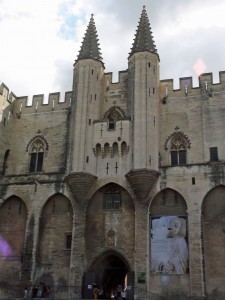
Entrance to the Palace of the Popes, Avignon
And even though the trip was cut short, it was cut neatly. I did everything I planned for the French leg of it, right up to getting into Salon-de-Provence with its Templar church and Nostradamus’s house, and into Avignon for a tour of the Palais du Papes [Palace of the Popes] yesterday. I would have been departing on the train for Basel this morning per the original plan, but it looks as if the Swiss-German portion of the trip, if it meant to be, is for another time. All this to say I have no regrets although it feels like I will have to revive some of my insights and enthusiasm for what I have seen and discovered about the Cathars after we have laid Mom’s body safely to rest. I do not find it coincidental that I was in the Basilica of St. Mary Magdalene in St. Maximin at or about the time of her actual passing.
There was, and still is, a bit of disorientation with this much change although it was always there as a possibility from the time I first heard that Mom was having difficulty. I still remember that spate of tears years back in the Colorado mountains when it came to me that she might be dying. It did not happen then or several other times when I suspected it might be the case. When it came I can’t say I was blind-sided, but still, getting that note from [my brother] Joe just after I had sent out a note to the family about the experience in St. Maximin caught me off-guard. I have not experienced that depth of “loss” or lower emotion for some time and the effects are curious… .
Still 45 minutes before the train comes. Am way ahead of myself on getting where I need to be yesterday and today, unlike most of the trip previously… .
There will be quite a few hours of waiting and/or sitting in what will literally be a long day now that I get all those crossing-the-Atlantic hours back. In a way looking forward to being back in NY, being in easier contact with the family, perhaps near friends who will share a hug with me in these emotional times.
Wish I could begin to write some sort of memorial for Mom or even get in the notes I made prior to her passing, but I will consider having done this much as progress, a duly captured moment, and perhaps my writer’s cap will plop back on naturally at some point. I should have volumes to say about the trip, even if cut short, but I trust my records are adequate enough to have that happen in the near future.

A well-preserved portion of the medieval walls of Avignon
[I did get back to the states in time to join the family for Mom’s burial service in Easton, Pennsylvania, where we were all born and raised. And I returned to Europe in October 2011 and completed the trip as originally planned in 2010. Click here to LINK to the first blog entry for the 2011 trip.]
******** Click to subscribe to this site’s RSS Feed.Click this link to order a copy of The Anathemas, a Novel about Reincarnation and Restitution.
Click to subscribe to this site’s RSS Feed.Click this link to order a copy of The Anathemas, a Novel about Reincarnation and Restitution.
Copyright 2012 by Victor E. Smith. All rights reserved.
Share your thoughts on this post. Put in your comment is the space below. Thank you.
Provence (Mary Magdalene), Wed. Aug. 25-Fri. Aug. 27, 2010
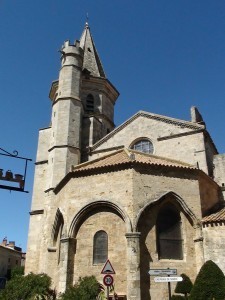
Saint Mary Magdalene Church, Bezier
With my arrival on Tuesday night, Aug. 24, in the city of Bezier to spend the next day in the area, I reached not only the outer perimeter of Cathar country (Bezier was the first frontier city to fall to the Crusaders in 1209) but also the gateway to a unexpected sequence of shrines and sights commemorating the enigmatic biblical character of Mary Magdalene. But the two are not unrelated. The Crusader attack on Bezier, the opening salvo of a cruel war that would go on for the next 35 years, occurred on July 22nd, the feast day of St. Mary Magdalene; and the battle’s tragic denouement was the torching of the cathedral dedicated to her, with all those taking refuge there, Catholics and Cathars, killed in the conflagration. It is said that Arnaud-Amaury, abbot of Citeaux , a commander of the crusade and the Papal Legate, when asked by a his troops how to tell Catholics from Cathars once they had taken the city, callously replied, “Kill them all, God will know His own.”
The Legend of Mary Magdalene in Provence
Despite its distance from the traditional biblical land, Mary Magdalene’s initials were inscribed across the beaches, towns and caves of southern France well before Dan Brown, in The Da Vinci Code, exploded the “secret” that Mary was married to Jesus and they had a son from whom the Merovingian dynasty derived. Brown, it turns out, was scooped by the Cathars themselves. An anonymous attachment to the Treatise against Heretics, states: “Also they [the Cathars] teach in their secret meetings that Mary Magdalene was the wife of Christ.”
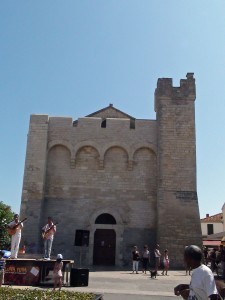
Basilica in Saintes-Maries-de-la-Mer
While the jury remains hung on this hypothesis that contradicts Christian teachings, an alternate legend, hardly less conventional, is alive and celebrated as fact throughout Provence, where a full complement of shrines, cathedrals and annual celebrations grace the places where it said Mary Magdalene lived, taught, prayed and eventually died.
The traditional story is that Mary, her brother Lazarus, and Maximinus, one of the Seventy Disciples, and her band, mostly woman, of primordial Christian evangelists, were expelled by persecutions from the Holy Land and miraculously crossed the Mediterranean in a frail boat without rudder or mast. The party landed on the Mediterranean coast at the place now called Saintes-Maries-de-la-Mer (the Holy Marys of the Sea, a reminder that the name “Mary” was a title of honor for a woman in biblical times, rather than the first name it later became). Mary Magdalene then went to Marseille and converted the whole of Provence, finally retiring to a cave on a hill called La Sainte-Baume (“holy cave”), where she gave herself up to a life of prayer and meditation for her remaining years. She received the last rites, died and was buried in the oratory of Saint Maximinus, her travelling companion, over which there stands today a magnificent Gothic cathedral dedicated, of course, to Saint Mary Magdalene.
The Magdalene Sites

High altar in Basilica of St. Mary Magdalene, Saint-Maximin-la-Sainte-Baume
During the next three days, August 25-27, the concept of pilgrimage, which was present when I started out from New York, came to the fore, especially with the news from home that my mother’s condition was growing more critical. During this time I was privileged to visit several of the monuments built in Mary Magdalene’s honor: the church in Bezier, the town and cathedral in Saintes-Maries-de-la-Mer, and on Friday the crypt containing her remains in the cathedral in Saint-Maximin-la-Sainte-Baume. A fortuitous event I captured on video, it happened that my 95-year-old mother passed away in Colorado as I entered the cathedral in Sainte-Baume to the sounds of an organ recital. I took that synchronicity as a personal sign from that valiant lady, our mother of ten, who sought solace and strength in the Catholic religion throughout her life, that she had finally reached that place of peace and rest for which she had so thirsted in her later years of failing health.

The sunset in Salon-de-Provence on Friday, Aug. 27, the date of my mother's passing
********
 Click to subscribe to this site’s RSS Feed.Click this link to order a copy of The Anathemas, a Novel about Reincarnation and Restitution.Copyright 2012 by Victor E. Smith. All rights reserved.
Click to subscribe to this site’s RSS Feed.Click this link to order a copy of The Anathemas, a Novel about Reincarnation and Restitution.Copyright 2012 by Victor E. Smith. All rights reserved.Share your thoughts on this post. Put in your comment is the space below. Thank you.



